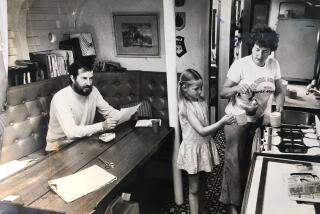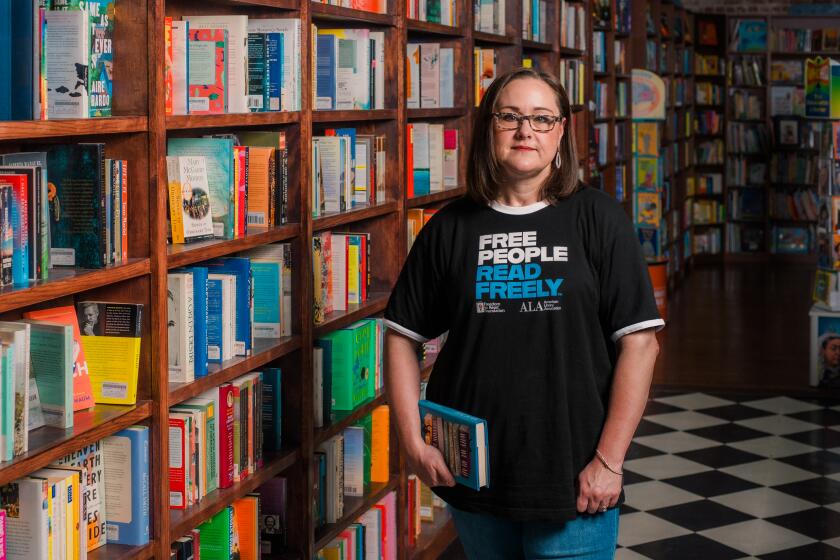Serendipity in the Stacks : THE CROWN OF COLUMBUS, <i> By Michael Dorris and Louise Erdrich (HarperCollins: $21.95; 373 pp</i> .<i> )</i>
To the layman, doing a casual bit of research in a university library, who are all those others ? Those slightly ruffled and abstract people, blending in with the books, who scuttle with such looks of dedication in and out of the stacks deep under the library--a trap that seemingly holds them for hours?
This deep-in-the-bowels world of the professional and would-be-professional scholar is the world populated by the protagonists in Michael Dorris and Louise Erdrich’s new novel, “The Crown of Columbus,” the first joint venture of these two gifted writers. Their protagonists are an oddly paired duo: 40-ish Vivian Twostar, an assistant professor and lecturer in anthropology at Dartmouth College, and her lover, Roger Williams, a full professor and poet. Except for an overwhelming physical and emotional need for each other, the two could hardly have less in common if they had been born of different species.
He, from the pin-neat cocoon of his bachelor home, regards it as a curiosity that he, somehow, is the father of the due-at-any-minute second child that encumbers Vivian. She is fighting her deadline for an article due to an alumni magazine on the impact of Christopher Columbus on the Native Americans of the 15th Century. As tiresome as the current research project is for Vivian, she is also under the gun because this is her critical year for establishing tenure (read, as she does: “lifetime paycheck”). While strong in two of the three elements that go into the granting, or denial, of tenure--”community service” and “teaching experience”--she has been criticized for weakness in the third area: “scholarly productivity.”
It is this gung-ho preoccupation with scholarly productivity that has given rise to the “publish or perish” sword that hangs over the entire academic world. And tenure is the constant fire under Vivian, sole support of her cantankerous Navajo grandmother and her 16-year-old son Nash, who has all of the habits that cause parents to gnash their teeth, plus a few of Dorris-Erdrich invention.
Vivian Twostar, who describes herself as Navajo-Irish and Sioux-by-marriage, and whose specialty at Dartmouth is Native American studies, is a natural protagonist for authors Dorris and Erdrich, since both not only come from an academic background but have deep roots in Indian culture. Dorris, founder and chairman of Dartmouth’s Native American studies program, is part Modoc, and Erdrich comes from a Chippewa mother.
Both, too, have impressive credentials in the writing field: Dorris is the author of the best seller “The Broken Cord,” which won the 1989 National Book Critics Circle Award, the Heartland Prize and the Christopher Award for nonfiction, as well as of the best-selling novel, “A Yellow Raft in Blue Water.” His own years of research in dusty library stacks are attested to by his scholarly “Native Americans: 500 Years After--A Guide to Research on North American Indians” (with Arlene Hirschfelder and May Lou Byler). Erdrich is the author of two books of poetry, “Jacklight” and “Baptism of Desire”; the best-selling novel, “Love Medicine,” winner of both the National Book Critics Circle and the Los Angeles Times Book Award for fiction in 1985; andtwo other best-selling novels, “The Beet Queen” and “Tracks.”
Vivian’s research on Columbus is doubly irritating for her since most of the volumes on hand are either all too familiar to her (she is, after all, an expert on Columbus) or already have been checked out by Roger, who is also a Columbus scholar and considers Vivian a dilettante in the field. He has been engaged for months in his own Columbus project, “Diary of a Lost Man,” an epic unrhymed monologue on that historic discovery.
Two experienced novelists such as these are not going to leave us stuck in Dartmouth’s gloomy stacks while Vivian Twostar plods dutifully through the yellowing books and portfolios dealing with Christopher Columbus’ maiden voyage to the new world--a voyage that, despite voluminous research, still remains frustratingly fuzzy. But it is in those dusty stacks that “The Crown of Columbus” takes off--and in a way that explains why this sort of stodgy research holds such appeal for scholars.
Tantalized by an occasional reference to a sheaf of correspondence having to do with the Columbus material, Vivian goes the next logical step and digs into the university’s depository--the equivalent of the attic of a family that hasn’t moved for generations: curiosities, odds and ends, random papers and jottings--everything that should be thrown away, but somehow isn’t.
It is there, in the correspondence of the Cobb family over three generations, that our mystery germinates. What are these “monumental” and earth-shaking pages that--in the mid-19th Century--Samuel Martin Cobb entrusted to his alma mater and which were never returned and which, since then, have been hotly pursued by Samuel’s heirs?
And so, back through many overlooked and yellowing pages, Vivian’s search takes her to two spiderweb-fragile pages that hint, tantalizingly, at being from Columbus’ personal diary. Mystery-on-mystery: a leather pouch with oyster shells bearing strange markings--directions to a treasure? And then a breakthrough: a more recent letter from the latest in the Cobb family, with a Bahamas return address, dated just a year earlier and, as usual, raising the same family hell about the return of these mysterious papers.
We’re catapulted from Dartmouth--Vivian, Roger, the recently born baby, Violet, and Nash (expenses courtesy of the affably eager Mr. Cobb)--to the island of Eleuthera. But what does the curious Mr. Cobb want of Vivian? Why does he keep returning to a few vague references to Columbus’ “crown”? A real “crown” in the traditional bejeweled sense, or simply a metaphor thrown casually into Vivian’s pages--by whom? Columbus? Or a forger?
“The Crown of Columbus” is a wonderful adventure/mystery story of a mismatched pair of scholars hopelessly out of their depth, dealing firsthand with evil but, in the process, discovering strengths in each other. There’s a lot of humor here, too, as Dorris and Erdrich poke good-natured fun at scholars generally, at each other, and, as an aside, at turf-protecting, posturing and status-squabbling dominating university faculties everywhere.
But there’s another fascinating side to “The Crown of Columbus.” For the first time, many of us will look on scholarship-for-scholarship’s sake with a new appreciation. Underneath all that dust, there are truths still to be discovered that will expand our world. And what about that crown?
More to Read
Sign up for our Book Club newsletter
Get the latest news, events and more from the Los Angeles Times Book Club, and help us get L.A. reading and talking.
You may occasionally receive promotional content from the Los Angeles Times.




